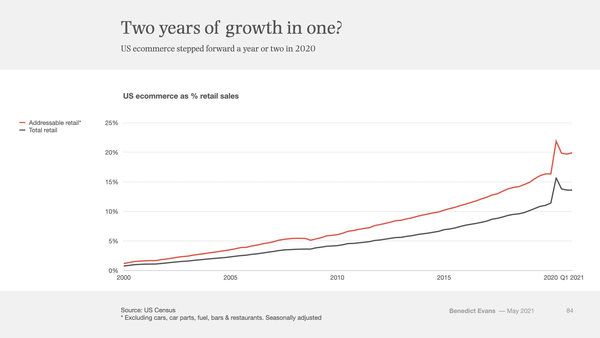It ain't all digital
Should we still be talking about online and offline retail, or about trucks versus boxes versus bikes?

By Capital Thinking • Issue #857 • View online
The traditional way to think about ecommerce penetration is to look at share of total retail sales, and then deduct things like car repair, gasoline and restaurants - to get to ‘addressable retail’.
On that basis, US ecommerce was at 16% penetration at the end of 2019 and increased to 20% or so in 2020, adding 12-18 months of growth in a year.
Boxes, trucks and bikes

The obvious problem with this analysis is that penetration of different retail categories varies a huge amount - penetration of makeup is different to books, which is different to shoes.
This reflects how different the buying journey can be for different kinds of products - we sometimes talk about ‘high touch’ versus ‘low touch’ goods.
The chart hides a lot of variation.
However, there’s also another way to split this, that I think is becoming increasingly important - instead of looking at the product category and the buying journey, look at the logistics model.
For Amazon, makeup, books and shoes are all just interchangeable SKUs with the same buying journey that can all be stored in the same fulfilment pod and all go into the same brown cardboard box, but a cucumber, a stove, a bag of cement or a bowl of soup do not fit this model at all - they might need a different buying journey, but they definitely need a different logistics model.
So, as well as thinking in terms of hardline versus softline, or high touch versus low touch, we should also think of parcels versus collection or delivery versus bikes.

In this chart, I’ve used BLS data to put grocery, home furnishings, appliances and building and garden materials into their own category - things that need collection or some kind of custom delivery.
This is obviously pretty fuzzy, and you could add and remove individual SKUs all day, but the base model for a weekly grocery shop, a fridge, or a garden project is that you go to the store, or the store brings it to you, and it doesn’t go through the mail, but that doesn’t mean it can’t be ‘ecommerce’ and doesn’t mean you can’t buy it online.
You can - you just need an entirely different supply chain and delivery model, with different unit economics.

Photo credit: Mark König on Unsplash
